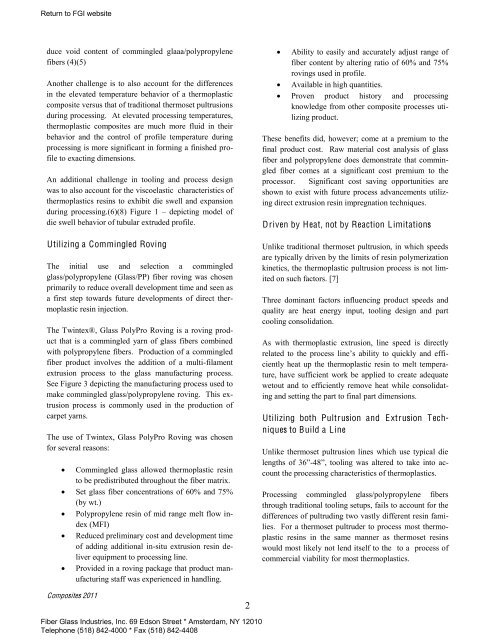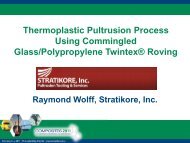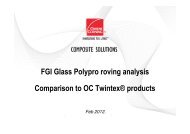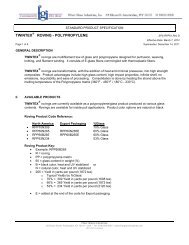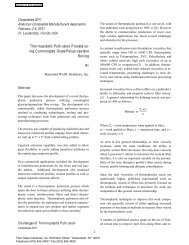Thermoplastic Pultrusion Process using commingled glass ...
Thermoplastic Pultrusion Process using commingled glass ...
Thermoplastic Pultrusion Process using commingled glass ...
Create successful ePaper yourself
Turn your PDF publications into a flip-book with our unique Google optimized e-Paper software.
Return to FGI website<br />
duce void content of <strong>commingled</strong> glaaa/polypropylene<br />
fibers (4)(5)<br />
Another challenge is to also account for the differences<br />
in the elevated temperature behavior of a thermoplastic<br />
composite versus that of traditional thermoset pultrusions<br />
during processing. At elevated processing temperatures,<br />
thermoplastic composites are much more fluid in their<br />
behavior and the control of profile temperature during<br />
processing is more significant in forming a finished profile<br />
to exacting dimensions.<br />
An additional challenge in tooling and process design<br />
was to also account for the viscoelastic characteristics of<br />
thermoplastics resins to exhibit die swell and expansion<br />
during processing.(6)(8) Figure 1 depicting model of<br />
die swell behavior of tubular extruded profile.<br />
Utilizing a Commingled Roving<br />
The initial use and selection a <strong>commingled</strong><br />
<strong>glass</strong>/polypropylene (Glass/PP) fiber roving was chosen<br />
primarily to reduce overall development time and seen as<br />
a first step towards future developments of direct thermoplastic<br />
resin injection.<br />
The Twintex®, Glass PolyPro Roving is a roving product<br />
that is a <strong>commingled</strong> yarn of <strong>glass</strong> fibers combined<br />
with polypropylene fibers. Production of a <strong>commingled</strong><br />
fiber product involves the addition of a multi-filament<br />
extrusion process to the <strong>glass</strong> manufacturing process.<br />
See Figure 3 depicting the manufacturing process used to<br />
make <strong>commingled</strong> <strong>glass</strong>/polypropylene roving. This extrusion<br />
process is commonly used in the production of<br />
carpet yarns.<br />
The use of Twintex, Glass PolyPro Roving was chosen<br />
for several reasons:<br />
Commingled <strong>glass</strong> allowed thermoplastic resin<br />
to be predistributed throughout the fiber matrix.<br />
Set <strong>glass</strong> fiber concentrations of 60% and 75%<br />
(by wt.)<br />
Polypropylene resin of mid range melt flow index<br />
(MFI)<br />
Reduced preliminary cost and development time<br />
of adding additional in-situ extrusion resin deliver<br />
equipment to processing line.<br />
Provided in a roving package that product manufacturing<br />
staff was experienced in handling.<br />
Composites 2011<br />
Fiber Glass Industries, Inc. 69 Edson Street * Amsterdam, NY 12010<br />
Telephone (518) 842-4000 * Fax (518) 842-4408<br />
2<br />
Ability to easily and accurately adjust range of<br />
fiber content by altering ratio of 60% and 75%<br />
rovings used in profile.<br />
Available in high quantities.<br />
Proven product history and processing<br />
knowledge from other composite processes utilizing<br />
product.<br />
These benefits did, however; come at a premium to the<br />
final product cost. Raw material cost analysis of <strong>glass</strong><br />
fiber and polypropylene does demonstrate that <strong>commingled</strong><br />
fiber comes at a significant cost premium to the<br />
processor. Significant cost saving opportunities are<br />
shown to exist with future process advancements utilizing<br />
direct extrusion resin impregnation techniques.<br />
Driven by Heat, not by Reaction Limitations<br />
Unlike traditional thermoset pultrusion, in which speeds<br />
are typically driven by the limits of resin polymerization<br />
kinetics, the thermoplastic pultrusion process is not limited<br />
on such factors. [7]<br />
Three dominant factors influencing product speeds and<br />
quality are heat energy input, tooling design and part<br />
cooling consolidation.<br />
As with thermoplastic extrusion, line speed is directly<br />
related to the process to <br />
quickly and efficiently<br />
heat up the thermoplastic resin to melt temperature,<br />
have sufficient work be applied to create adequate<br />
wetout and to efficiently remove heat while consolidating<br />
and setting the part to final part dimensions.<br />
Utilizing both <strong>Pultrusion</strong> and Extrusion Techniques<br />
to Build a Line<br />
Unlike thermoset pultrusion lines which use typical die<br />
- , tooling was altered to take into account<br />
the processing characteristics of thermoplastics.<br />
<strong>Process</strong>ing <strong>commingled</strong> <strong>glass</strong>/polypropylene fibers<br />
through traditional tooling setups, fails to account for the<br />
differences of pultruding two vastly different resin families.<br />
For a thermoset pultruder to process most thermoplastic<br />
resins in the same manner as thermoset resins<br />
would most likely not lend itself to the to a process of<br />
commercial viability for most thermoplastics.


